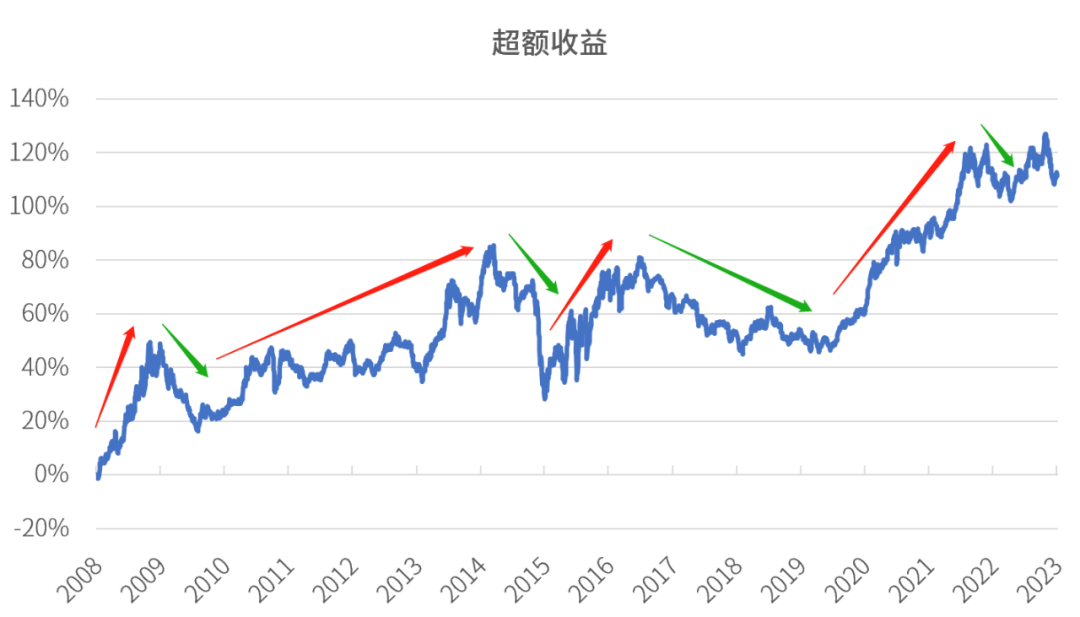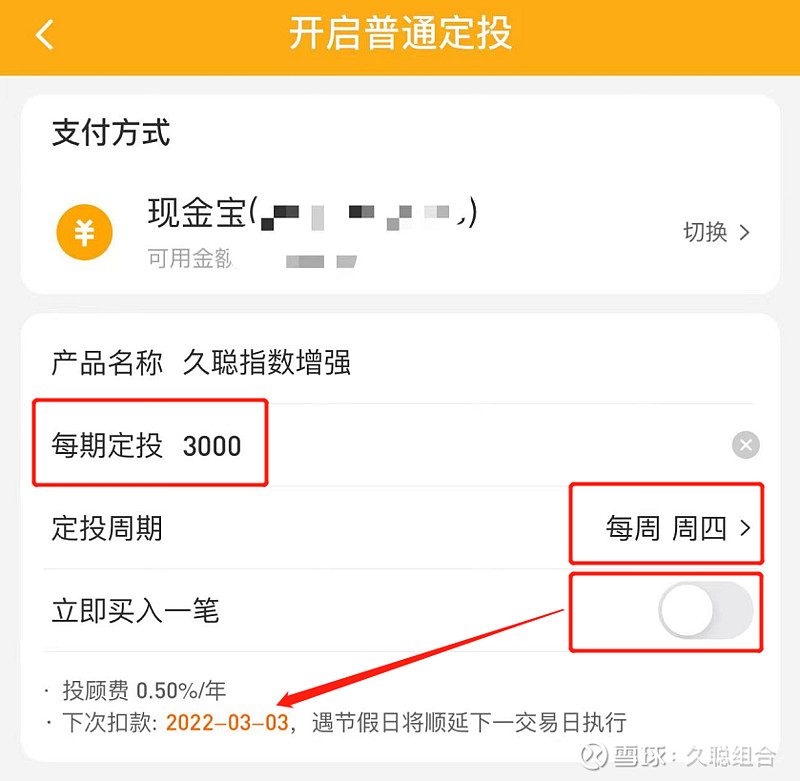#基金经理# $Jiu Cong Fund Manager Selection (TIAA026002)$ $Jiu Cong Fixed Income Plus(TIAA026005)$ $Jiu Cong Index Enhancement(TIAA026003)$
In the past two years of 2020 and 2021, active funds have performed very well, outperforming indexes such as the Shanghai and Shenzhen 300 by a large margin, creating a group of star fund managers and attracting many new investors to the market. However, since 2022, the excess return advantage of active funds seems to have disappeared, and many funds have also underperformed the index.
Can active funds achieve excess returns in the future? Let’s first look at the laws of history.
Active funds are represented by the “Wonder Partial Stock Hybrid Fund Index”. Partial stock hybrid funds are the most important type of active funds. The index of Wind includes all partial stock hybrid funds that have been established for more than 3 months. It is compiled according to equal weights and can be approximately regarded as partial stock active funds. average performance.
Using the CSI 300 Total Return Index as a benchmark for comparison, this index is based on the CSI 300 Index plus dividend income, which can be approximately regarded as the performance of holding the CSI 300 ETF.
In the past 15 years, the comparison chart of the two trends is as follows:

(Data source: wind)
In the past 15 years, active funds have achieved good excess returns relative to the Shanghai and Shenzhen 300, and they do have the ability to outperform the market.
Next is the second question. Are there any rules for the excess returns created by active funds? Can they achieve excess returns stably?
The answer is no.
The figure below shows the excess return of the Wind Partial Stock Hybrid Fund Index relative to the CSI 300 Total Return Index. The blue curve in the figure goes up, indicating that the active fund outperformed the CSI 300 at this stage. On the contrary, the blue curve goes down, indicating this stage Active funds underperformed the CSI 300:

(Data source: wind)
It can be seen that the excess return of active funds has a certain period. In the figure, the red arrow marks the major stage when the active fund outperforms the index, and the green arrow marks the major stage when the active fund underperforms the index. The short stage may be 1 year, and the long stage may be more than 3 years. In these large stages, smaller bands can also be subdivided. On a monthly or quarterly basis, active funds and index funds alternately outperform each other.
Can you predict who will win in the next stage? It is difficult to draw a definite rule.
For example, from 2010 to 2014, although there were various small bands in the middle, active funds continued to create excess returns on the whole. If we look at this data from 2014, we will think that active funds are an excellent choice. But then from 2016 to 2018, active funds continued to underperform and experienced a 3-year downturn. If you lose confidence in active funds at this time, you will miss the golden age of active funds from the second half of 2019 to 2021.
It is as difficult to choose whether active funds or index funds are better for the next stage, like guessing whether the stock market will rise or fall.
To summarize: Historically, active funds have been able to achieve excess returns relative to broad-based broad-based indexes for a long time, but they do not consistently outperform at any time, and the excess returns have certain periodicity.
After understanding this rule, many problems encountered when holding active funds will be answered.
For example, some readers asked, why did active funds perform so well in the past few years, but when I bought them in 2022, they failed? In fact, this is not surprising. This is the law of active funds in history. It takes time for active funds to surpass the index, and it is normal to underperform periodically. Only by understanding and accepting these can you use this tool well.
For example, some readers asked, if the recent performance of active funds has been average, is there any hope for the future? If you look at history, you will know that the cycle has its own reincarnation, and the long-term average effect of active funds is still very promising. But also note that the average effect is mentioned here, and active funds with poor performance may also underperform for a long time. Therefore, when we choose active funds, we should pay attention to decentralized allocation, choose fund managers we trust, and build a decentralized portfolio , long-term holding, excess returns are more likely to bear fruit.
This is the way of thinking of Jiu Cong’s optimal combination of fund managers. While examining the fund manager’s experience, performance, stock selection ability, and company strength, he selects about 10 outstanding fund managers for one-stop buying, which is the best choice for long-term investment in active funds. Good tool, everyone is welcome to experience it.
Scheduled votes continue to start this week :
Today, the stock-bond spread valuation quantile is 9.10%, the A-share PE quantile is 35.40%, and the PB quantile is 11.30%. The valuation is in the middle to low range, which is suitable for fixed investment rights and interests. The following is the regular investment plan for this issue, welcome to participate, the same as last week:
Scheduled investment starts every Wednesday night, and gives advice on the proportion of fixed investment in stocks and bonds for the week based on valuation. You can refer to the stock-to-debt ratio and make a fixed investment once a week.
Proposals for the allocation of funds for this period:
Shares: 100%
Optional “Jiu Cong Index Enhancement” or “Jiu Cong Fund Manager Selection”
Debt: 0%
Optional “Jiu Cong Bond”
Example of fixed investment plan
Investor Xiaojiu will invest 3,000 yuan a week.
100% investment in this issue, she believes more in indexed investment, and chose 3,000 yuan for Jiucong index enhancement. Do not buy Jiucong bonds for the time being.
Click this link to enter the Jiu Cong Index Enhancement page, click “Transfer” to manually set the investment, click “Scheduled Investment” to set automatic deduction every week, it is recommended to set the deduction date to be every Thursday.
Her regular investment settings are as shown in the figure below. When setting up for the first time, you need to pay attention to the date of “Next Deduction”. If the next deduction date is this Thursday, you don’t need to open “Buy One Now”. If it is next Thursday, you need to turn on “Buy Now”.

common problem
1. I prefer actively managed funds. Can I choose “ Jiu Cong Fund Manager ‘s Choice” for the investment part?
Can.
Jiucong fund managers preferably include active funds, and Jiucong index enhancements include index funds.
There is no absolute advantage or disadvantage between indexed investment and actively managed investment. From a historical perspective, the performance of the two has also won and lost in different periods. Which one to choose depends on which investment logic you believe in more: I hope to be closer to the average return of the market, follow the rise of the market, and be suitable for indexed investment; I hope to use the ability of fund managers to strive for some excess returns, and at the same time bear more Deviation from the market risk, more suitable for actively managed investments.
2. If the proportion of the bond part is not 0% in the future, how should I make a fixed investment?
For the bond part, you can choose ” Jiu Cong Bond “, and the operation method is the same as above.
3. How much is the minimum purchase amount for fixed investment?
At present, the minimum purchase amount of each combination is 200 yuan. However, considering that each period of fixed investment needs to allocate funds between the two combinations of stocks and bonds, it is recommended that the weekly fixed investment amount should be at least 500 yuan in order to realize the adjustment of the ratio of stocks and bonds. If you feel pressure to invest 500 yuan per week, you can choose to vote once every two weeks.
4. Any other precautions?
Regular investment requires long-term participation, at least 3 years is recommended, short-term funds do not participate. In the future, when the price-to-performance ratio of stocks and bonds changes, the proportion of stocks and bonds for each scheduled investment may change, and stock holdings may also need to be adjusted from stock portfolios to bond portfolios, and from bond portfolios to stock portfolios, in order to achieve stock-bond rotation. There will be a prompt on the number, and manual operation is required to switch between combinations, please stay tuned.
The above plans are just examples, and investors should make reasonable arrangements for investment plans according to their own capital situation and risk tolerance. Funds are risky, and investment needs to be cautious. The investment advisory institution does not guarantee the certain profitability and minimum return of the above fund investment portfolio strategies, nor does it make a commitment to guarantee capital. The fund investment consulting business is still in the pilot stage, and there is a risk that fund investment consulting institutions will not be able to continue to provide services due to the cancellation of the pilot qualification.
There are 4 discussions on this topic in Xueqiu, click to view.
Snowball is an investor social network where smart investors are all here.
Click to download Xueqiu mobile client http://xueqiu.com/xz ]]>
This article is transferred from: http://xueqiu.com/4340615795/239800687
This site is only for collection, and the copyright belongs to the original author.